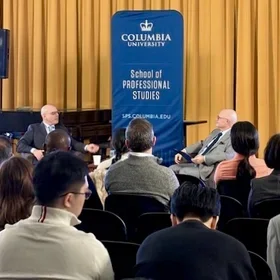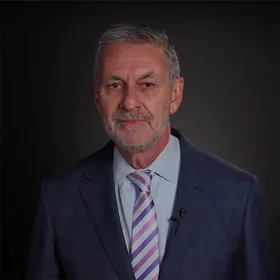By Iza Martinez
Braddock Linsley is the co-director of Columbia University's Master of Science in Sustainability Science program (SUSCI), offered by the School of Professional Studies in partnership with the Climate School, director of the Lamont-Doherty Earth Observatory Stable Isotope and Trace Element Laboratory, and a Lamont Research Professor. Linsley joined Lamont in 2011 following a 16-year tenure as a professor in the Department of Atmospheric and Environmental Sciences at the University at Albany-SUNY (SUNYA). Originating from the Connecticut shore, his lifelong interest in the oceans has guided his academic and research pursuits.
As the co-director of SUSCI, he plays a pivotal role in shaping the curriculum and mentoring students, in addition to teaching the “Monitoring and Analysis of Marine and Estuary Systems” course. In this interview, he delves deeper into his roles and shares some highlights from his research, teaching, and leadership experiences.
How has the study of paleoceanography impacted our understanding of climate today and moving forward? To what extent do you believe lawmakers create research-based climate policies?
James Hutton proposed in 1785 that for geologic processes, the “present is the key to the past.” He meant that understanding environmental processes at work today can serve as a guide for understanding the geologic record. For paleoclimatic research, we do the opposite. We are trying to reconstruct past climatic conditions at different time scales as a guide to understanding the forcing mechanisms for global and regional climate and then forecasting how Earth's global and regional climate might change in the future.
Although I appreciate that there are complicated economic issues related to rapidly reducing emissions, I think policymakers are moving too slowly to effectively mitigate global warming and sea level rise. Ocean acidification is a poorly understood result of excess atmospheric CO2 with unknown effects on marine organisms at the base of food chains. We are all contributing to a global-scale experiment with unknown outcomes.
Your research has taken you to many diverse international destinations. Have these travels shaped who you are today? Where did you make the best memories or obtain the most significant results?
I always tell students to follow their interests. Mine led me to sedimentary geology, micropaleontology, late Pleistocene tropical Pacific paleoceanography, and then to coral-based paleoclimatic reconstruction over the last several centuries. These resulted in sediment coring cruises in the Sulu and Bismarck Seas and coral work across multiple Pacific sites: Panama, Clipperton Atoll, Hawaii, Fanning Atoll, Rarotonga, Tonga, Fiji, American Samoa, and the Great Barrier Reef.
Despite all these diverse field sites, I have spent 95% of my career analyzing samples in the lab or interpreting data in my office.
Coral paleoclimate reconstruction has taught me that my preconceived assumptions about oceanographic and climate processes at my study sites are often incomplete or simplistic. Close examination of site-specific data often reveals unexpected interpretations. This is true for all environmental data. Keeping an open mind when interpreting and remembering your assumptions is essential.
Please share a bit about the “Monitoring and Analysis of Marine and Estuary Systems” course. What can students expect to take away from this class?
I have taught the class for the last five years in the SUSCI program. Its content grew out of a course I first designed as a Professor at SUNYA before I arrived at Lamont-Doherty. There, I realized that the study of modern environmental processes could be a stand-alone class from more "traditional" paleoclimatic classes. Specifically, I try to explore what I call the modern processes' "gray zone." Through evaluation of data, scientific papers, and discussion, I show students that there are many aspects of base-line modern processes (open ocean primary production and atmospheric CO2 uptake, atmospheric heat sequestration by the surface ocean, and marine organism response to ocean acidification) that we do not fully understand.
We also explore local and regional processes important for sustainability; for example, the uncertainty around sea level rise effects on coastal communities and estuaries, and the pros and cons of enhancing coastal resilience with living shorelines (saltmarshes, oyster reefs, and mangroves) versus hard structures (seawalls and groins). The ultimate objective is to equip students to evaluate solutions for the many challenges facing marine and coastal sustainability.
What do you enjoy about teaching? How is it different from doing research?
Teaching is most rewarding when I see students master a skill, grasp a new concept, or more fully understand an environmental process or issue. My field sampling work is a team effort, but my lab-based and analytical research is a largely solitary endeavor. Data is reduced and interpreted, and "written up" for unknown anonymous reviewers. Discussing results/data with students often leads to insightful questions and new or revised interpretations. This is one of the most gratifying aspects of my position.
As someone with a unique insight into the development of SUSCI, how has the program evolved to meet the demands of contemporary sustainability leadership since its inception in 2018?
The foundation of the SUSCI program curriculum was initially laid by our faculty, who each submitted separate course proposals for new classes. Most SUSCI course topics were not dictated from the top down but are related to the specific expertise of the instructor who proposed the class. Early on, we realized that the SUSCI student body was even more academically diverse than we had envisioned, spanning science, modeling, quantitative analysis, and business administration. The decision was made to pivot to only three required classes and give students the option to develop their own course of study tailored to their specific interests.
This pivot is paying off, and the SUSCI program's growth is accelerating. We enrolled 23 new students this past fall. This is our largest incoming class in the six years of the program. The program will continue to adjust, adapt, and evolve to best meet the intellectual needs of our students. I find it very rewarding to have been involved from the beginning and to see the program expand.
About the Program
The Columbia University M.S. in Sustainability Science program, offered by the School of Professional Studies in partnership with the Climate School, prepares students for management and leadership positions in which they help organizations understand the technical aspects of sustainability, including predicting and addressing environmental impacts. Students learn strategies to respond to the ever-changing environment, predict future environmental changes, and examine how these shifts affect society.
The fall 2025 application deadline for the M.S. in Sustainability Science program is May 1. Learn more about the program here.
The program is customized for working professionals and is offered as both a full- and part-time course of study. Students have the flexibility to choose from a variety of courses to position themselves for career advancement. New York City serves students as a living laboratory for developments in sustainability practice, and as a source of many employers who hire program graduates.


